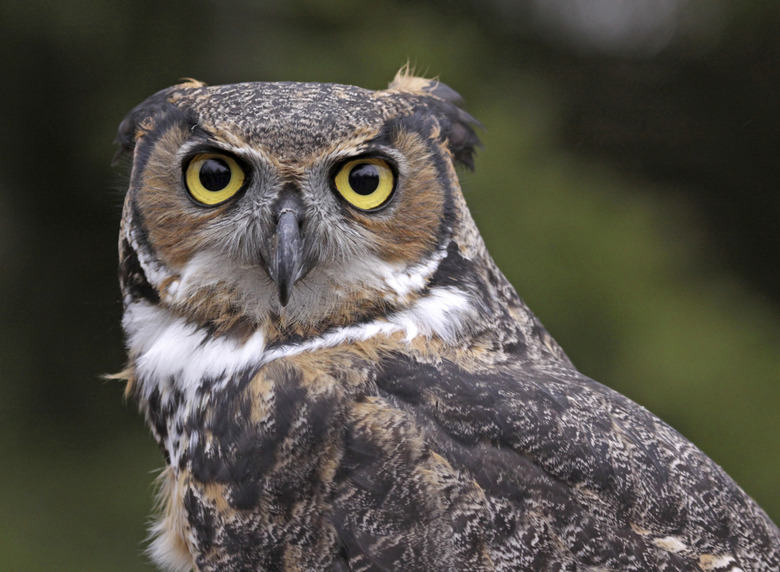Night Birds Of North America
A number of North American birds are more active at night than during the day – that is, they're nocturnal. Nocturnal birds can avoid many diurnal, or day-active, predators; exploit prey out and about under the cover of darkness; or otherwise take advantage of particular nighttime conditions. Nighttime birds sometimes have proportionally large eyes – to better take advantage of dim light – or exhibit other special adaptations. Several groups of nocturnal North American birds particularly stand out.
The Owls
The Owls
The best-known nocturnal birds in North America are the owls, nighttime counterparts of falcons, hawks and eagles. North American owls range in size from the little elf owl of the southwestern deserts to the massive and formidable snowy and great horned owls. Besides stellar night vision and hearing, owls rely on nearly silent flight to approach prey: The leading edge of their wing-feathers is jagged, or "fluted," muffling air turbulence for quieter wingbeats. This distinctive "woosh," is characteristic of bird noises at night. Not all North American owls fall in the nocturnal category: The northern and ferruginous pygmy owls, northern hawk owl, short-eared owl, and snowy owl are mostly diurnal.
Nightjars and Nighthawks
Nightjars and Nighthawks
These rather strange-looking birds, which belong to the family Caprimulgidae, sometimes go by the collective name "goatsuckers," thanks to an archaic and erroneous belief that they robbed goats of their milk. Camouflaged like leaf litter or bark, nightjars and nighthawks spend the day resting on the ground or heavy branches, then take wing at night to snatch insects out of the air with their huge, bristle-lined mouths. Nightjars are famous for their loud, loopy calls, which give several North American species – the whip-poor-will, Chuck-will's-widow and poor-will – their onomatopoeic names. Somewhat more conspicuous than the big-headed nightjars are the nighthawks, slimmer and longer-winged birds that are often seen hunting the dusk skies.
The Night Herons
The Night Herons
The black- and yellow-crowned night herons are two closely related wading birds most active, as their names suggests, after the sun's gone down. During the day, the birds roost, often communally, in trees or shrubs. Both are relatively small and stocky herons, though the yellow-crowned is more slender than the other. Black-crowned night herons have an enormous global range and are widely distributed in the United States; yellow-crowned night herons are restricted to the Southeast. The two relatives also diverge a bit diet-wise: Though both stalk wetlands, lakes and rivers, the black-crowned mostly targets fish, while the yellow-crowned is mainly a crab and crayfish eater.
Nocturnal Seabirds
Nocturnal Seabirds
A number of seabirds are primarily or occasionally nighttime birds, a trait that – in addition to helping them avoid predation by raptorial birds – allows them to take advantage of night-active fish, squid and plankton, and also helps them navigate by celestial clues. Nocturnal seabirds in North America include many petrels, shearwaters and auks, such as the rhinoceros auklet of the Pacific coast. Such night fliers can be attracted or disoriented by the lights of fishing boats, oil platforms and other man-made apparatuses.
Migrant Birds That Fly at Night
Migrant Birds That Fly at Night
Many kinds of otherwise diurnal North American birds migrate at night, including numerous species of songbirds and shorebirds. For long-distance migrants, nocturnal travel offers a number of advantages: The typically calmer and cooler atmospheric conditions make it easier and less exhausting to fly, and there's less threat of predation given daylight-hunting hawks and falcons aren't an issue. You can often detect night-flying migrants by listening for their bird noises at night, or watching a bright moon through binoculars or a spotting scope. On heavy migration nights, you might spot the silhouettes of steadily passing nocturnal birds.
References
- How to Spot an Owl; Patricia Taylor Sutton
- Guide to Owl Watching in North America; Donald S. Heintzelman
- Birds of the Dominican Republic and Haiti; Steven Latta et al.
- The Cornell Lab of Ornithology: All About Birds — Yellow-crowned Night-Heron
- The Cornell Lab of Ornithology: All About Birds — Black-crowned Night-Heron
- BirdLife International: Light Pollution Has a Negative Impact on Many Seabirds Including Several Globally Threatened Species
- Oregon Coast Aquarium: Rhinoceros Auklet
Cite This Article
MLA
Shaw, Ethan. "Night Birds Of North America" sciencing.com, https://www.sciencing.com/night-birds-north-america-5979144/. 16 July 2018.
APA
Shaw, Ethan. (2018, July 16). Night Birds Of North America. sciencing.com. Retrieved from https://www.sciencing.com/night-birds-north-america-5979144/
Chicago
Shaw, Ethan. Night Birds Of North America last modified March 24, 2022. https://www.sciencing.com/night-birds-north-america-5979144/
